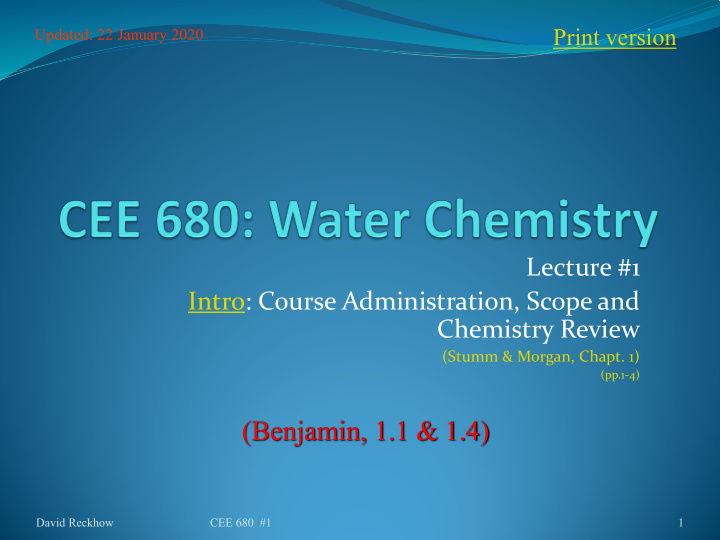



Print version Updated: 22 January 2020 Lecture #1 Intro: Course Administration, Scope and Chemistry Review (Stumm & Morgan, Chapt. 1) (pp.1-4) (Benjamin, 1.1 & 1.4) David Reckhow CEE 680 #1 1
David Reckhow CEE 680 #1 2
David Reckhow CEE 680 #1 3
David Reckhow CEE 680 #1 4
David Reckhow CEE 680 #1 5
Zimbabwe Zimbabwe Botswana Mozambique df Namibia David Reckhow CEE 680 #1 6
David Reckhow CEE 680 #1 7
Course Administration Course Syllabus Textbook: Benjamin, Water Chemistry, 2 nd Edition, Waveland Press, 2015 must read, not all topics may be covered Detailed Course Outline Homework policy most graded; Projects MINEQL, review of literature Web site David Reckhow CEE 680 #1 8
Other References Langmiur, Aqueous Environmental Geochemistry, Prentice-Hall, 1997. 1. Pankow, Aquatic Chemistry Concepts. Lewis Publ., Chelsea, MI, 1991 2. Stumm & Morgan, Aquatic Chemistry. 3rd Ed., John Wiley & Sons., 1995 3. Extra copy on shelf in 3 rd floor Elab II office UM Science GB855 .S78 1996 Jensen, A problem Solving Approach to Aquatic Chemistry, Wiley, 2003. 4. UM Science GB855 .J46 2003 Sawyer, McCarty & Parkin, Chemistry for Environmental Engineering, McGraw 5. Hill, 2003. Extra copy of 3 rd edition on shelf in 3 rd floor Elab II office 6. Eby, Principles of Environmental Geochemistry, Cengage Learning, 2004. Brezonik & Arnold, Water Chemistry, Oxford Univ Press, 2011 7. FC On line: GB855 .B744 2011eb 8. Snoeyink & Jenkins, Water Chemistry, John Wiley & Sons., 1980. UM Science QD169.W3 S66 David Reckhow CEE 680 #1 9
Relation with Environmental Engineering Math Environmental Physics Biology Engineering Chemistry David Reckhow CEE 680 #1 10
Relation with Classic Chemistry Disciplines CEE 680 Physical Analytical Chemistry Chemistry Water Chemistry CEE 572 & 772 Inorganic Organic Chemical Analysis 697z Chemistry Chemistry CEE 684 680 684 Chemical Kinetics Thermodynamics Kinetics CEE 697z Organics in water CEE 680 is very similar to Geo-Sci 519 (Aqueous Environmental Geochemistry David Reckhow CEE 680 #1 11
Interdisciplinary sub-fields From Brezonik & Arnold, 2011 David Reckhow CEE 680 #1 12
Others Geo-Sci 519 With lab. Chemical processes affecting the distribution and circulation of chemical compounds in natural waters. Geochemistry of precipitation, rivers, lakes, groundwater, and oceans; applications of thermodynamic equilibria to predicting composition of aqueous systems. Behavior of trace metals and radionuclides in near surface environments. Prerequisite: Chem 111, 112. David Reckhow CEE 680 #1 13
General Questions for Water, Soil & Geochemists What is the chemical composition of natural waters? Will it change with time, location? What happens to chemical species when they enter new aquatic or non-aquatic environments? How does transport affect the chemistry? What types of reactions occur in managed natural systems? What do we need to do to make it work better? David Reckhow CEE 680 #1 14
Examples for Water Treatment How can we use chemistry to stop corrosion and dissolution of lead? What with the pH, alkalinity and hardness be after mixing two different types of water e.g., groundwater and surface water How do we get the best performance from chemical precipitation processes e.g., coagulation, softening What can we do to optimize oxidation treatments e.g., removal of Mn, trace organic constituents David Reckhow CEE 680 #1 15
Solving real problems Why was this water treatment plant once perfectly designed for treating its raw water? Why has air pollution control rendered it far less effective? How can it be re-designed to work well again? David Reckhow CEE 680 #1 16
Disinfection with Free Chlorine Required contact time increases with pH 600 Chlorine Residual Time for 3 log Giardia inactivation (minutes) 10C 0.4 mg/L 500 0.8 mg/L 10°C 1.2 mg/L Based on 1.6 mg/L 2.0 mg/L 400 USEPA CT tables 300 200 100 0 5.5 6.0 6.5 7.0 7.5 8.0 8.5 9.0 9.5 David Reckhow pH CEE 680 #1 17
DOC removal by alum coagulation Impacts of pH and dose 9 450 Control (no alum) 400 8 20ºC 7 350 Soluble Manganese ( µ g/L) 24 mg/L dose 6 300 48 mg/L dose DOC (mg/L) 5 250 4 200 96 mg/L dose 3 150 Manganese 2 100 Rennes IV Raw Water Mn precipitation (France) 11/19/84 1 50 Reckhow & Bourbigot (unpublished data) 0 0 4 5 6 7 8 9 10 11 12 pH
1400 DBP Formation 1200 Effect of pH TOX 1000 Concentration ( µ g/L) with free chlorine 800 600 TTHM 400 TCAA 200 DCAA 0 From: Reckhow & 2 4 6 8 10 12 Singer, 1984 (4.2 mg/L TOC, 3 days, 20 pH mg/L dose, 20 o C)
Flint water crisis Edwards slide David Reckhow CEE 680 #1 20
Elemental abundance in fresh water From: Stumm & Morgan, 1996; Benjamin, fig 1.4; Langmuir figure 8.12 David Reckhow CEE 680 #2 21
To next lecture David Reckhow CEE 680 #1 22
Recommend
More recommend